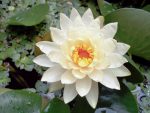 Also known as fragrant water lily and beaver root, this aquatic deciduous perennial is a member of the Nymphaeaceae, a family of 75 species of aquatic plants including pond lilies. It is native to most of North American growing in up to 8′ of water in ponds, lakes, and slow moving water. Growing from a root system of long forking rhizomes and fibrous roots embedded in sediment, plants put up 2 different kinds of stems. One type bears almost almost circular, leathery, floating leaves that are up to 4-12″ across, medium green on top, reddish to purplish beneath, and deeply cut almost to the center where the stem is attached. The other type of stem bears terminal, solitary, bowl-shaped flowers that are 2-6″ across, fragrant, and float on the water. Each flower has up to 20-30 white petals that are 3/4-4′ long, pointed, and surround a boss of up to 70 golden stamens. From summer to early fall, each flower opens during the day and close at night and on very cloudy days for 3-4 days before giving way to a multicelled fruit that matures underwater . When released, the seeds float on the surface of the water as they are carried by currents, winds, or waves, then sink to the bottom and germinate unless eaten by the wildlife that find them. An excellent choice for a pond or water garden. The genus name, Nymphacea, comes from the Greek word numphaios and means sacred to the nymphs. The specific epithet, odorata, is the Latin word meaning smelling and refers to the fragrance of the flowers.
Also known as fragrant water lily and beaver root, this aquatic deciduous perennial is a member of the Nymphaeaceae, a family of 75 species of aquatic plants including pond lilies. It is native to most of North American growing in up to 8′ of water in ponds, lakes, and slow moving water. Growing from a root system of long forking rhizomes and fibrous roots embedded in sediment, plants put up 2 different kinds of stems. One type bears almost almost circular, leathery, floating leaves that are up to 4-12″ across, medium green on top, reddish to purplish beneath, and deeply cut almost to the center where the stem is attached. The other type of stem bears terminal, solitary, bowl-shaped flowers that are 2-6″ across, fragrant, and float on the water. Each flower has up to 20-30 white petals that are 3/4-4′ long, pointed, and surround a boss of up to 70 golden stamens. From summer to early fall, each flower opens during the day and close at night and on very cloudy days for 3-4 days before giving way to a multicelled fruit that matures underwater . When released, the seeds float on the surface of the water as they are carried by currents, winds, or waves, then sink to the bottom and germinate unless eaten by the wildlife that find them. An excellent choice for a pond or water garden. The genus name, Nymphacea, comes from the Greek word numphaios and means sacred to the nymphs. The specific epithet, odorata, is the Latin word meaning smelling and refers to the fragrance of the flowers.
Size: 2-8′ H v 2-4′ W
Light: full sun but tolerates shade
Soil: Wet, acidic
Hardiness: Zones 3-11
Care: Contain to reduce spread: fertilize monthly
Pests and Diseases: None of significance
Propagation: Division, seed
Companion Plants: Lotus, pond lily, water poppy, pickerel weed
Photo Credit: Wikipedia